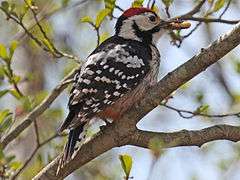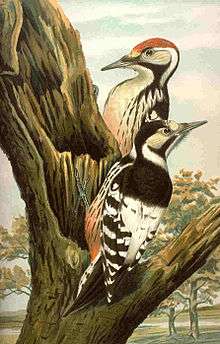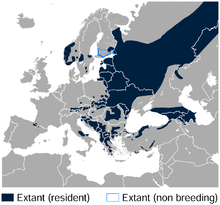White-backed woodpecker
| White-backed woodpecker | |
|---|---|
 | |
| Male D. leucotos | |
 | |
| D. leucotos pair | |
| Scientific classification | |
| Kingdom: | Animalia |
| Phylum: | Chordata |
| Class: | Aves |
| Order: | Piciformes |
| Family: | Picidae |
| Genus: | Dendrocopos |
| Species: | D. leucotos |
| Binomial name | |
| Dendrocopos leucotos (Bechstein, 1802) | |
 | |
| White-backed Woodpecker range[2] | |
 | |
| White-backed Woodpecker range in Europe and western Asia[2] | |
The white-backed woodpecker (Dendrocopos leucotos) is a Eurasian woodpecker belonging to the genus Dendrocopos.
It is the largest of the spotted woodpeckers in the western Palearctic, 24–26 cm long with wing-span 38–40 cm and has plumage similar to the great spotted woodpecker, but with white bars across the wings rather than spots, and a white lower back. The male has a red crown, the female a black one.[3]
The nominate race D. l. leucotos occurs in central and northern Europe, with the race D. l. lilfordi found in the Balkans and Turkey. Ten further races occur in the region eastwards as far as Korea and Japan. It is a scarce bird, requiring large tracts of mature deciduous forests with high amounts of standing and laying dead wood. Numbers have decreased in Nordic countries. In Sweden, its population decline has caused the Swedish government to enact protection for the species in the national Biodiversity Action Plan.[4] In the breeding season it excavates a nest hole about 7 cm wide and 30 cm deep in a decaying tree trunk. It lays three to five white eggs and incubates for 10–11 days. It lives predominantly on wood-boring beetles as well as their larvae, as well as other insects, nuts, seeds and berries. Drumming by males is very loud, calls include a soft kiuk and a longer kweek.
Subspecies
There are twelve recognised subspecies.[5][6]
- D. l. leucotos (Bechstein, 1802), the nominate subspecies, widespread across Eurasia from north, central and eastern Europe to northeast Asia, Korea and Sakhalin.
- D. l. lilfordi (Sharpe & Dresser, 1871) Pyrenees to Asia Minor, Caucasus and Transcaucasia.
- D. l. tangi (Cheng, 1956) Sichuan province, western China.
- D. l. subcirris (Stejneger, 1886) Hokkaido, northern Japan.
- D. l. stejnegeri (Kuroda, 1921) northern Honshū, Japan.
- D. l. namiyei (Stejneger, 1886) south Honshū, Kyushu, Shikoku, Japan, and Cheju-do island, Korea
- D. l. takahashii (Kuroda & Mori, 1920) Ullung Island (off eastern Korea).
- D. l. owstoni (Ogawa, 1905) Amami-O-Shima Island in the northern Ryukyu Islands, Japan.
- D. l. fohkiensis (Buturlin, 1908) mountains of Fujian province, southeast China.
- D. l. insularis (Gould, 1863) Taiwan.
- D. l. quelpartensis (Kuroda & Mori, 1918).
- D. l. uralensis (Malherbe, 1860).
Line note references
- ↑ BirdLife International (2012). "Dendrocopos leucotos". IUCN Red List of Threatened Species. Version 2013.2. International Union for Conservation of Nature. Retrieved 26 November 2013.
- 1 2 BirdLife International and NatureServe (2014) Bird Species Distribution Maps of the World. 2014. Dendrocopos leucotos. In: IUCN 2014. The IUCN Red List of Threatened Species. Version 2014.3. http://www.iucnredlist.org. Downloaded on 27 May 2015.
- ↑ The Birds of the Western Palearctic [Abridged]. OUP. 1997. ISBN 0-19-854099-X.
- ↑ National Biodiversity Action Plan of Sweden, Upsala (1999)
- ↑ "GlobalTwitcher.com: White-backed Woodpecker Dendrocopos leucotos".
- ↑ "eol Encyclopedia of Life: Dendrocopos leucotos".
References
- Gorman, Gerard (2004): Woodpeckers of Europe: A Study of the European Picidae. Bruce Coleman, UK. ISBN 1-872842-05-4.
